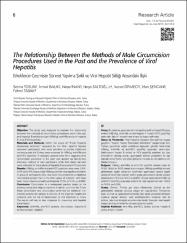The relationship between the methods of male circumcision procedures used in the past and the prevalence of viral hepatitis

Göster/
Erişim
info:eu-repo/semantics/openAccessTarih
2016Yazar
Tosun, SelmaBalık, İsmail
İnan, Neşe
Saltoğlu, Neşe
Örmeci, Necati
Şencan, İrfan
Tabak, Fehmi
Üst veri
Tüm öğe kaydını gösterKünye
Tosun S, Balik I, Inan N, Saltoğlu N, Ormeci N, Sencan I, Tabak F. The relationship between the methods of male circumcision procedures used in the past and the prevalence of viral hepatitis. Viral Hepatitis Journal 2016; 22(1):6-9. doi: 10.4274/vhd.65487Özet
Objective: The study was designed to evaluate the relationship between the methods of circumcision procedures used in the past and hepatitis B surface antigen (HBsAg), anti-HBs and anti-hepatitis C virus (HCV) positivity.
Materials and Methods: Within the scope of “Public Hepatitis Awareness Activities” executed by the Viral Hepatitis Society, volunteer participants who were admitted to primary healthcare centers across the Turkey, were screened for HBsAg, anti-HBs and anti-HCV positivity. A standard questionnaire form regarding their circumcision procedure in the past was applied via face-to-face interview method to each participant while their blood samples were collected for the analysis of hepatitis B virus and HCV positivity. Amaç: Bu çalışma, geçmişte sünnet yapılma şekli ve hepatit B yüzey antijeni (HBsAg), anti-HBs ve anti-hepatit C virüsü (HCV) pozitifliği arasındaki ilişkinin incelenmesi amacı ile dizayn edilmiştir.
Gereç ve Yöntemler: Viral Hepatitle Savaşım Derneği’nce hayata geçirilen “Toplum Hepatit Farkındalık Aktiviteleri” kapsamında, tüm Türkiye genelinde sağlık ocaklarına başvuran gönüllü katılımcılar HBsAg, anti-HBs ve anti-HCV pozitifliği açısından taranmıştır. Katılımcıların hepatit B virüsü ve HCV pozitifliği analizleri için kan örneklerinin alındığı sırada, geçmişteki sünnet prosedürü ile ilgili standart anket formu yüz yüze görüşme metodu ile her katılımcı için doldurulmuştur.

















